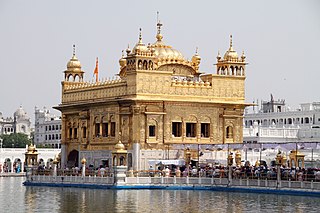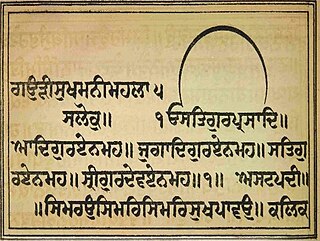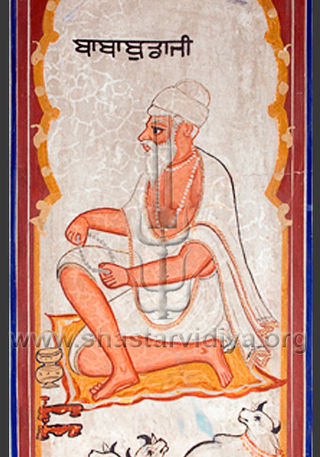
Sikhism, also known as Sikhi, is an Indian religion and philosophy in particular for the Sikh ethnoreligious group that originated in the Punjab region of India around the end of the 15th century CE. The Sikh scriptures are written in the Gurumukhi script particular to Sikhs. It is one of the most recently founded major religious groups and among the largest in the world, with about 25–30 million adherents.

A gurdwara or gurudwara is a place of assembly and worship for Sikhs but its normal meaning is place of guru or "Home of guru". Sikhs also refer to gurdwaras as Gurdwara Sahib. People from all faiths and religions are welcomed in gurdwaras. Each gurdwara has a Darbar Sahib where the Guru Granth Sahib is placed on a takht in a prominent central position. Any congregant may recite, sing, and explain the verses from the Guru Granth Sahib, in the presence of the rest of the congregation.

The Guru Granth Sahib is the central holy religious scripture of Sikhism, regarded by Sikhs as the final, sovereign and eternal Guru following the lineage of the ten human gurus of the religion. The Adi Granth, its first rendition, was compiled by the fifth guru, Guru Arjan (1564–1606). Its compilation was completed on 29 August 1604 and first installed inside the Golden Temple in Amritsar on 1 September 1604. Baba Buddha was appointed the first Granthi of the Golden Temple. Shortly afterwards Guru Hargobind added Ramkali Ki Vaar. Later, Guru Gobind Singh, the tenth Sikh guru, added hymns of Guru Tegh Bahadur to the Adi Granth and affirmed the text as his successor. This second rendition became known as the Guru Granth Sahib and is also sometimes referred to as the Adi Granth.

Guru Amar Das, sometimes spelled as Guru Amardas, was the third of the Ten Gurus of Sikhism and became Sikh Guru on 26 March 1552 at age 73.
The following outline is provides an overview of Sikhism, or Sikhi.

Sukhmani Sahib, known under the title of Gauri Sukhmani in the scripture, is usually translated to mean Prayer of Peace is a set of 192 padas present in the holy Guru Granth Sahib, the main scripture and living Guru of Sikhism from Ang 262 to Ang 296. This Gurbani text was written by the 5th Guru, Guru Arjan (1563–1606) at Amritsar in around 1602. Guru Arjan first recited the bani at Gurdwara Barth Sahib in the Gurdaspur district of Punjab, India.

The Sikh gurus are the spiritual masters of Sikhism, who established the religion over the course of about two and a half centuries, beginning in 1469. The year 1469 marks the birth of Guru Nanak, the founder of Sikhism. He was succeeded by nine other human gurus until, in 1708, the Guruship was finally passed on by the tenth guru to the holy Sikh scripture, Guru Granth Sahib, which is now considered the living Guru by the followers of the Sikh faith.

Sikh music, also known as Gurbani Sangeet , and as Gurmat Sangeet, or even as Shabad Kirtan, is the classical music style that is practised within Sikhism. It exists in institutional, popular, and folk traditions, forms, and varieties. Three types of Sikh musicians are rababis, ragis, and dhadhis. Sikh music exists in various melodic modes, musical forms, styles, musicians, and performance contexts.

The principal Sikh scripture is the Adi Granth, more commonly called the Guru Granth Sahib. The second most important scripture of the Sikhs is the Dasam Granth. Both of these consist of text which was written or authorised by the Sikh Gurus.
Guru Nanak founded the Sikh religion in the Punjab region of the northern part of the Indian subcontinent in the 15th century and opposed many traditional practices like fasting, janeu, idolatry, caste system, ascetism, azan, economic materialism, and gender discrimination.

Bhai Gurdas was a Sikh writer, historian and preacher who served as the Jathedar of the Akal Takht from 1606 to his death in 1636. He was the original scribe of the early version of Guru Granth Sahib, having served as the amanuensis of Guru Arjan in its compilation.

A Ragi is a Sikh musician who plays hymns (shabads) in different ragas as prescribed in the Sri Guru Granth Sahib.

Sri Chand, also referred to as Baba Sri Chandra or Bhagwan Sri Chandra, was the founder of the Udasi sect of ascetic Sadhus. Sikh sources give his life the impressive dates of 8 September 1494 – 13 January 1629, which would have made him 134 years old upon his death.

Rababi is a term used to refer to a player of the rabab instrument.

Balvand Rai also spelt as Balwand and Rai Balvand, was a poet mystic and rabab player in the court of Guru Arjan.

The Guru Granth Sahib, is the central religious text of Sikhism, considered by Sikhs to be the final sovereign Guru of the religion. It contains 1430 Angs, containing 5,894 hymns of 36 saint mystics which includes Sikh gurus, Bhagats, Bhatts and Gursikhs. It is notable among foundational religious scriptures for including hymns from writers of other religions, namely Hindus and Muslims. It also contains teachings of the Sikh gurus themselves.

The Mīnās were a heretical sect of Sikhs that followed Prithi Chand, the eldest son of Guru Ram Das, after his younger brother Guru Arjan was selected by the Guru to succeed him. Prithi Chand would vigorously contest this, attracting a portion of Sikhs to his side who followers of Guru Arjan referred to as ਮੀਣੇ mīṇe, meaning "charlatans," "dissemblers," or "scoundrels." They sustained their opposition to the orthodox line of Gurus through the seventeenth century, and upon Guru Gobind Singh's founding of the Khalsa in 1699, they were declared by him, as well as by Khalsa rahitnamas, as one of the Panj Mel, or five reprobate groups, that a Sikh must avoid. They are occasionally referred to in the more neutral terms Sikhān dā chhotā mel or as the Miharvān sampraday in scholarship.

Baba Buddha was a prime figure in early Sikhism.

Babak, was a Sikh rababi or musician, who kept Guru Hargobind company and recited sacred hymns at morning and evening.


















